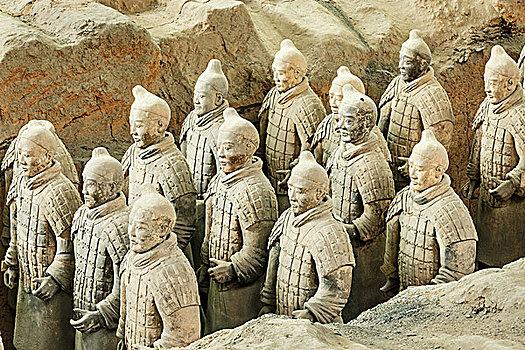
How Old is the Terracotta Army?
The Terracotta Army is over 2,200 years old, built from 247 BC or 246 BC to 208 BC. This awe-inspiring collection of life-sized terracotta sculptures was created to accompany the tomb of Qin Shi Huang, the first emperor of China.
The Reign of Qin Shi Huang
Qin Shi Huang, born in 259 BC, ascended to the throne of the Qin state at the tender age of 13. His reign marked a pivotal period in Chinese history as he successfully unified the Warring States, ending centuries of conflict. He became the first emperor of a unified China in 221 BC, taking the name Qin Shi Huang, meaning "First Emperor of Qin."
The Construction of the Mausoleum
According to the historical record "Shih Chi" (Records of the Grand Historian) by Sima Qian, the young king Qin Shi Huang, driven by a desire to secure his power and legacy in the afterlife, ordered the construction of his grand mausoleum shortly after his coronation. The project, of unimaginable scale and ambition for its time, would continue for nearly four decades, even beyond his death in 210 BC.
The Purpose of the Terracotta Army
The Terracotta Army was not merely an artistic endeavor but served a profound symbolic and spiritual purpose. These figures, each uniquely crafted with meticulous detail, represented the emperor's loyal army, meant to protect and serve him in the afterlife. The vastness of the army, with its soldiers, chariots, and horses, reflects the emperor's power and the grandeur of his reign.
Discovering the Terracotta Army
Lost to the world for centuries, the Terracotta Army was rediscovered in 1974 by local farmers digging a well near Xi'an, China. This accidental discovery would send shockwaves through the archaeological community and beyond, revealing an unprecedented glimpse into China's ancient past.
The Legacy of the Terracotta Army
Today, the Terracotta Army stands as a UNESCO World Heritage site, captivating millions of visitors each year. This incredible collection offers an invaluable window into the military practices, artistry, and cultural beliefs of ancient China. More than just an army of clay, the Terracotta Army serves as an enduring testament to the ambition, vision, and legacy of Qin Shi Huang, the First Emperor of China.
Q&A
Q: Why did Qin Shi Huang commission the creation of the Terracotta Army?
A: Qin Shi Huang believed that the Terracotta Army would protect him in the afterlife and help him rule with the same power and authority he held in the mortal world.
Q: How many figures are estimated to be in the entire Terracotta Army?
A: While only a portion has been excavated so far, archaeologists estimate that the Terracotta Army may contain over 8,000 soldiers, 130 chariots with 520 horses, and 150 cavalry horses.
Q: What makes the Terracotta Army so remarkable beyond its sheer size?
A: The individual details of each figure, from their facial features and hairstyles to their armor and weapons, demonstrate the advanced craftsmanship of the time. The sheer variety and realism of the sculptures offer incredible insight into the military structure and individual roles within Qin Shi Huang's army.